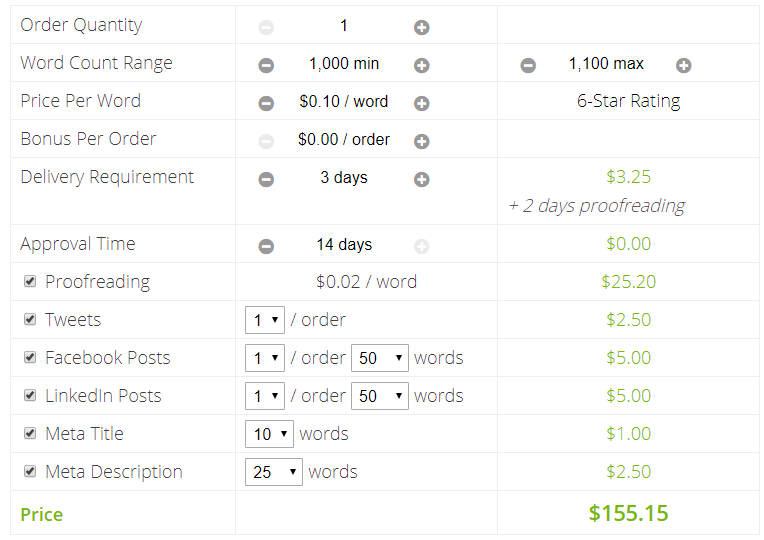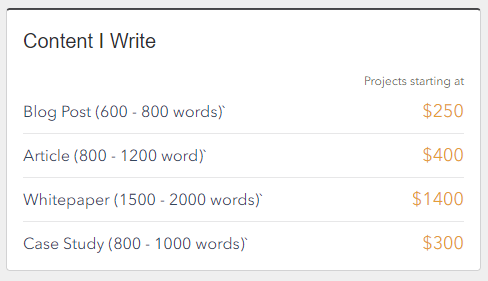How Much Does A Blog Post Cost? [1,000 Words, High-Quality, B2B, Agency vs. Freelancer]
Nothing is more frustrating than getting an evasive answer, like "it depends", when you have a burning question. What does it depend on?
Unfortunately, asking how much a blog post costs is similar to asking how much it costs to build a house. Just like the square footage and whether or not you would like a basement or a second story determine the ultimate investment, so too is the cost of blog posts dependent on multiple factors, such as word count, quality of the writer, and more.
Today, I want to walk you through all of the elements that go into a blog post and show you how they influence the price tag.
Goal: Creating A High-Quality 1,000 Word Blog Post For The B2B Tech Space
Please note: The goal would be to create an outstanding blog post that addresses your primary buyer persona in a specific stage in their buyer's journey. If you are looking for the average cost of a blog post for the sake of filling your blog and checking another to-do off your list, this might NOT be the right resource for you.
Let's compare apples to apples and define briefly what types of blog posts I am talking about:
- Short-form blog posts are usually between 500 and 800 words and should be used for announcement type articles, e.g., to talk about a new product feature, help promote an upcoming webinar, and similar.
- Long-form blog posts (this is what we will be comparing!) are between 800 and 2,000 words and span anything from in-depth how-to article to strategic discussions and can include side-by-side product bake-offs, detailed explanations of complex technological problems, and alike.
- Cornerstone content takes the long-form blog post to the next level. They are only written on very selective topics and will cover strategically important industry issues in great detail (breadth and depth). This can be done in a long, very well structured blog post or in a formal pillar page. These tend to be between 1,500 and 3,500 words long, can often be downloaded as a PDF, and are linked to relevant internal content, like other blog posts.
While exact pricing will depend on your location, your industry, and your needs, I will try to provide you with a real-world view of what the true cost of a blog post in the B2B enterprise technology sector would be.
What Does A Blog Post Cost (Freelancer vs. Agency)?
I know — you want to get to the actual money part. Therefore, I will talk about the fully-loaded cost first, before going through each of the steps in more detail.
Because every second organization outsources at least some of its content marketing (with content creation leading the charge as the most outsourced activity at 84%), we will look at the cost of creating a blog post as part of a long-term retainer engagement with a B2B Technology inbound marketing agency who manages all or most of the inbound marketing efforts and compare it to the cost of managing the process internally but hiring a freelancer for the blog writing.
.png?width=1024&name=FullyLoadedCostOfAB2BTechBlogPost%20(2).png)
Using Freelancer & Internal Marketing Resources
We compared the fully loaded cost based on marketing averages (as of December 2019). For any internal jobs, I assumed an hourly rate of $25/hour as most companies will utilize a marketing employee somewhere between a junior marketing associate ($22.56/ hour based on an average yearly salary of $44,000) and a marketing project manager ($30.77/ hour based on an average yearly salary of $60,000). For freelancer jobs, I used industry standards and explained how I arrived at that number.
For a high-quality 1,000-word B2B tech blog post using a combination of freelancer and internal marketing resources, you can expect to pay:
- Choosing the topic, finding the writer and creating the brief, project managing the freelancers [Internal - $75]
- Initial research & blog post writing [Freelancer - $275]
- Editing [Freelancer - $200]
- Graphic Design [Freelancer - $100]
- Uploading & Optimization [Internal - $75]
- Lead Generation Optimization [Internal - $25]
- Promoting of Social Media [Internal - $25]
Total Cost: $775
As Part Of A Retainer Engagement With A Specialized B2B Tech Inbound Marketing Agency
Many of the more reputable B2B tech inbound marketing agencies are using a point-based pricing system that increases flexibility, accountability, and transparency. Essentially, you buy a monthly retainer that will give you a specific number of credit points. Those are often broken up into must-do activities (foundation builders that are required for long-term success) and campaign-related activities that are more flexible. Blog posts can be made depending on your needs.
Let's say the agency's point model requires 4 credits for a short-form blog post and 6-8 credits for a long-form blog post. Now you can multiply that by the credit value, e.g., $110 to $130 — pricing depends on the agency you partner with and the size of your retainer. In this example, your 1,000-word blog post costs you $660 to $1040. For the sake of this calculation, we will go with the average of $825 — which includes everything from initial research, project management, content strategy, and blog writing to optimizing and promoting the finished blog post.
Total Cost: $825
Now that we know what the cost per blog post is, let's look at how I got to this number.
The "Operational" Costs Of A Blog Post: Initial Research & Content Writing
Let's start with the most obvious: the initial research and content creation. When most people think of blog post creation, they think of the actual writing process. This is why I am calling this the operational costs. There is a lot more that goes into creating an outstanding blog post — as we will explore in a minute.
Initial Research
Ideally, your blog post topic comes from a well-maintained editorial calendar which is created based on a documented content strategy (more about this at the end of the blog post). If you are managing your content creation internally and with the help of freelancers, your marketing resource will need to decide on the topic and create a detailed brief for the writer. This can include some initial internal research or even a short interview with internal subject matter experts.
Then you will need to find the right writer and brief him or her. After you have briefed your writer, they will have to do some initial research of their own. The amount needed will, of course, depend on the:
- Topic — Writing about the features of the latest Windows 10 upgrade will require less in-depth knowledge that an article on how to achieve maximum Windows-as-a-Service velocity upgrades in an enterprise context.
- Writer — How much background knowledge does he or she have (i.e., I am a computer scientist with 20+ years of industry experience covering Microsoft, so it is easier for me to write about any related topic in the technology space than someone who has no or little background knowledge)?
- Availability of subject matter experts — An interview with a subject matter expert on a specific topic can prove invaluable as it not only adds real-world insights and experience to the article, but also cuts down on the research time significantly.
You might ask yourself right now why you can't just do the initial research yourself, create an outline, and give it to a freelance writer to write up. Unfortunately, in this industry, this strategy will most likely result in a little superficial initial research to understand the context of the blog post followed by creating fluffy filler text to reach the desired number of words as most freelance writers' arrangements are by the word count. So be sure to select your writer carefully.
When going the agency route, you can expect the right agency partner to become an extension of your team and to know your product and competitive landscape extremely well. The initial research period is shorter, less involved, and can often be done in a short phone interview or even by the agency marketer.
The Actual Writing
Once the initial research is completed, possible subject matter interviews are done, and the outline is created, the actual writing begins. Your primary audience, B2B tech buyers, usually research a topic very thoroughly — looking for technical specifications and any information they can find. Long gone are the days where "no one ever got fired for buying IBM", so understandably, your audience wants to be absolutely sure before kicking off massive internal technology initiatives.
If your internal marketing team is not intimately familiar with the topic and can not write the article in house, finding a freelance writer that can deliver outstanding B2B tech content will be like winning the lottery. There are very few good writers out there, and they command a high price.
By the way, even with inbound marketing agencies that specialize in B2B technology, you are often hard-pressed to find someone who will
- Produce content in-house (most agencies outsource content production to the same group of freelancers you could hire) and
- Get acquainted enough with your product and market to have sufficient background knowledge.
So be sure to ask how content creation is done before hiring an agency to write your B2B Tech content. Once you find the right agency, you will know by the quality of the content and the feedback you receive.
Freelancers Charge Between $150 And $400+ For A 1,000 Word Blog Post — But That Only Includes Basic Research & Writing
In Upwork's pricing guide on content creation, it states: "On Upwork, the rates for top content writers can range from as low as $15 dollars an hour to as high as $80, though most fall in the $30-50 range. Rates can vary due to many factors, including expertise and experience, location, and market conditions."
An experienced writer will be able to write a 1,000 word blog post (assuming it is their field of expertise and extensive initial research isn't required) within 3 to 4 hours. Assuming the higher medium range for the sake of calculation, the blog post would cost about $150 to $200.
With WriterAccess.com, you have a different approach. You can submit an order to a specific writer, a selective group of writers, or to the entire community on a first-served-basis. You set the parameters (e.g., how much you want to pay per word, what level of writer you require, what your delivery timeline is, etc.) and the writers decide if they want to take the job. But as you see below, a 1,000 word blog post with a good writer would run you about $150 as well.

On a more specialized platform, like nDash, that allows you to hire veteran tech industry writers, expect to pay at a minimum $400 for a 1,000 word blog post.

For the sake of our calculation, we stick with the industry standard and assume that the freelance writer will carry out basic initial research based on our detailed brief and write the 1,000 word blog post for an average cost of $275 — even though for the quality we are looking for in this article, we should go to the higher end of the spectrum.
The Often-Forgotten & Always Underestimated Tactical Costs
For most people, the blogging effort and cost stops here. But in reality, writing is only about 20 percent of blogging. The rest is optimization and promotion.
Editing
Now that the blog post is written, it needs to be edited. This is not only important to appear professional and provide an excellent reader experience, but also counts for your search engine rankings!
Usually, freelance writers do not edit their blog posts, although most platforms give you the option of basic proofreading for an additional fee (around $0.02 per word).
But there is a huge difference between proofreading a text for spelling mistakes and having an experienced editor correct your content for grammatical mistakes, readability, and context. If you hire a freelance writer, you will need to also then hire an editor. For example, the editing of a 1,000 word blog post by a senior editor on WriterAccess will cost an additional $200.
Of course, the time spent and the cost required will significantly decrease if:
- The blog post is well-written. Did the writer use proper grammar and spelling consistently? For example, if a writer consistently makes mistakes, a good editor will switch tactics and painstakingly comb through each word and sentence to avoid missing something.
- There is an established relationship between the editor and the writer. If the writer can hand off a piece of work directly to the editor and they have a well-defined process, there is less time spent going back and forth. For example, if edits can be made directly by the editor in the blog post, it saves time as the editor doesn't have type out the errors in an email and the writer doesn't have to work them in.
- The editor is familiar with the industry and proprietary terms.
In addition, a great editor will also check for comprehension, readability, and consistency:
- Is this the clearest way to say this?
- Does the whole piece flow logically?
- Are titles, abbreviations, and acronyms written in a consistent manner all throughout the piece?
- Are headings, subheadings, and other styles consistent throughout?
Graphic Design
Depending on the topic of your blog post, you will need to add certain visual elements to complete your content. This could be as simple as finding a suitable featured image, saving it in the correct size, and uploading it — or it could be as involved as taking screenshots of a software you are writing about.
If you hired a freelancer, you will now need to do it internally or hire a graphic designer. Creating a featured blog post image and finding appropriate high-quality stock images can be done for $50-$100 (including the licensing fees for the images) per blog post. When working with an inbound marketing agency, the featured image and other images will be included in the credits required for the blog post.
Sometimes, an infographic is useful to visualize a process or provide additional context. Graphic designers will charge somewhere between $250-$500 for more involved infographics, while some inbound marketing agencies will allow for smaller infographics for a cornerstone blog post without additional cost (that's what we do). More involved infographics might require extra credits. But the majority of blog posts do not require infographics, so for our calculation, we will not include the infographic.
Uploading & SEO Optimization
Once the blog post is edited, it needs to be uploaded, formatted, and optimized. These basic tasks are important for the user experience and performance of your blog post and should be done with care. This includes:
- Uploading raw text
- Formatting of headers, subheaders, quotes, and other text elements
- Linking to older related internal blog posts as well as to external sources
- Adding a Call-to-Action on the bottom of the blog post as well as where appropriate in other strategic places
- Creating and uploading a featured image
- Assigning an author (and possibly creating a new author profile and bio)
- Creating and embedding any infographics or videos that should be included
- Taking care of the on-page search engine optimization, including writing the meta description, meta title, and image alt tags
If done thoroughly, this process can take up to 2-3 hours, can be done by a junior marketing associate, and will cost you an additional $50-$75 when going the freelance route.
(Obviously, for the inbound marketing agency route, this is already included in the credits for the blog post and doesn't cost anything extra).
Lead Generation Optimization
While your first goal of blogging is to help your primary buyer persona to answer their questions, your ultimate goal is lead generation. By allowing your readers to download an eBook, a whitepaper, or in some cases even a PDF version of the article, you can fill your sales pipeline with interested contacts in different stages of their buyer's journey.
Depending on the article, consider adding Call-to-Action buttons in strategic places — within the context of the text where appropriate (e.g., you have a resource that would be very helpful to mention in your article, so feel free to do so and add a link so your readers can easily find it) or on the bottom of the blog post. The more your offered resource relates to the question answered by the blog post, the more likely it is that your reader clicks on the CTA or fills out a form.
If you are using a marketing automation solution like Hubspot, adding a CTA is as easy as clicking a button. This would look something like this:
But this can get more involved if you first have to create a PDF from your article as well as a corresponding form and thank you page, or you need to design a CTA button and add it in WordPress, etc. On average though, the workload should not exceed more than an hour per blog post, so we will estimate $25 for the freelancer/internal marketing route.
(Again, this is something an inbound marketing agency will already have included in its pricing.)
Promote Your Blog Post On Social Media & Other Content Distribution Channels
Now that your blog post is finished, it is time to publish it and promote it. Depending on your content promotion strategy, you might want to schedule social media posts on Twitter and LinkedIn, and maybe even on Instagram and Facebook if your company uses those channels. Each post requires a slightly different text (including some strategic hashtags) and image sizes. Since 80% of B2B leads come from LinkedIn, investing some time in carefully crafting custom copy (say that three times fast!) to be shared on the author's LinkedIn profile is well worth the time.
But you don't have to stop here. If you interviewed or mentioned thought leaders or other organizations in your blog post, reach out to them, let them know about the article, and ask them to share it. If your blog post answered an issue discussed on Reddit, Quora, or even Microsoft TechNet, feel free to share it there — but only if it is super helpful and not promotional!
Of course, you can also add this article to your PPC campaign or pay for a sponsored LinkedIn post. However, for the sake of this calculation, we will only assume that we create and schedule 3 posts on the organization's Twitter and LinkedIn pages and one post on the blog author's LinkedIn profile. For a junior marketing associate, the writing of the copy, creating the images, and uploading should take no longer than 2 hours, costing you about $50 on the freelance route (it is included for the inbound marketing retainer).
This concludes our calculations for the operational and tactical costs for a single blog post. However, I feel it is very important to mention content strategy in this context as well.
Content Strategy
Noone starts building a house by finishing the first room and then wondering where to put the second room. You need a plan — an architectural blueprint. The same is true for blogging and content marketing. Having a well-defined, formally documented content strategy is crucial to the success of your blogging and inbound marketing.
But why do so many organizations just start writing without a proper strategy? It literally is like throwing something against the wall to see if it sticks — it is ineffective and delivers a low return-on-investment.
Not convinced? "The B2B Content Marketing 2020 Report — Benchmarks, Budgets, and Trends—North America" recently asked organizations if they had a documented content strategy. 69% of the most successful content marketing teams say they do while only 16% of the least successful ones have bothered.
This includes, for example:
- Defining your buyer personas and their buyer's journey,
- Breaking a complex topic into logical, easy-to-digest pieces,
- Definition of important cornerstone content, e.g., your pillar page, content clusters, and supporting blog posts,
- Creation of an editorial calendar,
- Integration with other ongoing or planned marketing campaigns, and
- Utilization and reusing of existing content assets.
This work needs to be done internally or with an inbound marketing agency. If you are working with an inbound marketing agency, this is done at the beginning of the retainer and repeated every year. For example, we like to run a 2-day workshop (in person if we can) to not only get everyone in the organization on board with inbound marketing, but also to define their buyer personas and their respective buyer's journeys as well as their positioning and messaging. Based on that and further internal research, we define a cohesive inbound marketing strategy including the content strategy for the next 12 months.
Conclusion
Producing high-quality blog articles isn't cheap — whether you do it in-house, with a team of freelancers, or by partnering with an agency. But would it be worth it if one blog post like this could directly influence $150,000 in revenue? Not every single blog post will perform like this; even if only 1% of your blog posts can generate that much revenue, your ROI will still be very high.
Share this
You May Also Like
These Related Stories
![Marketing Agency vs. In-House Marketing + Coaching [A Side-By-Side Cost Comparison]](https://blog.3pcreativegroup.com/hubfs/Marketing%20Agency%20vs.%20In-House%20Marketing%20+%20Coaching%20%5BA%20Side-By-Side%20Cost%20Comparison%5D.png)
How Much Does It Cost To Hire A Marketing Agency vs. Doing Your Own Marketing (Incl. Coaching)?

B2B Content Marketing: How Much Does It Cost Per Month & How Can The Cost Be Reduced?

.png?width=250&height=125&name=TrustBuilderLogoWhiteTranspBackgr(250x125%20px).png)




No Comments Yet
Let us know what you think